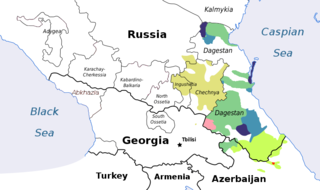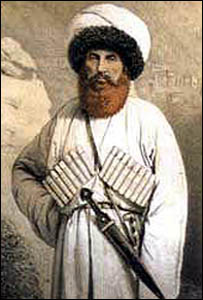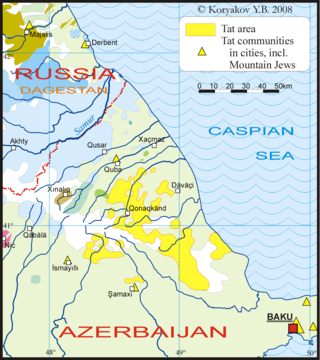
The Northeast Caucasian languages, also called East Caucasian, Nakh-Daghestani or Vainakh-Daghestani, is a family of languages spoken in the Russian republics of Dagestan, Chechnya and Ingushetia and in Northern Azerbaijan as well as in diaspora populations in Western Europe and the Middle East. They are occasionally called Caspian, as opposed to Pontic for the Northwest Caucasian languages.
Avar, also known as Avaric, is a Northeast Caucasian language of the Avar–Andic subgroup that is spoken by Avars, primarily in Dagestan. In 2010, there were approximately 1 million speakers in Dagestan and elsewhere in Russia.

The Avars, also known as Maharuls are a Northeast Caucasian ethnic group. The Avars are the largest of several ethnic groups living in the Russian republic of Dagestan. The Avars reside in the North Caucasus between the Black Sea and the Caspian Sea. Alongside other ethnic groups in the North Caucasus region, the Avars live in ancient villages located approximately 2,000 m above sea level. The Avar language spoken by the Caucasian Avars belongs to the family of Northeast Caucasian languages. Sunni Islam has been the prevailing religion of the Avars since the 13th century.

The Caucasian languages comprise a large and extremely varied array of languages spoken by more than ten million people in and around the Caucasus Mountains, which lie between the Black Sea and the Caspian Sea.

Dagestan, officially the Republic of Dagestan, is a republic of Russia situated in the North Caucasus of Eastern Europe, along the Caspian Sea. It is located north of the Greater Caucasus, and is a part of the North Caucasian Federal District. The republic is the southernmost tip of Russia, sharing land borders with the countries of Azerbaijan and Georgia to the south and southwest, the Russian republics of Chechnya and Kalmykia to the west and north, and with Stavropol Krai to the northwest. Makhachkala is the republic's capital and largest city; other major cities are Derbent, Kizlyar, Izberbash, Kaspiysk, and Buynaksk.

The Tat language, also known as Caucasian Persian, Tat/Tati Persian, or Caucasian Tat, is a Southwestern Iranian language closely related to, but not fully mutually intelligible with Persian and spoken by the Tats in Azerbaijan and Russia. There is also an Iranian language called Judeo-Tat spoken by Mountain Jews.

Judeo-Tat or Juhuri is the traditional language of the Mountain Jews of the eastern Caucasus Mountains, especially Azerbaijan and Dagestan, now mainly spoken in Israel.
The Udi language, spoken by the Udi people, is a member of the Lezgic branch of the Northeast Caucasian language family. It is believed an earlier form of it was the main language of Caucasian Albania, which stretched from south Dagestan to current day Azerbaijan. The Old Udi language is also called the Caucasian Albanian language and possibly corresponds to the "Gargarian" language identified by medieval Armenian historians. Modern Udi is known simply as Udi.
Godoberi is an Andic language of the Northeast Caucasian language family spoken by the Godoberi in southwestern Dagestan, Russia. It is spoken by approximately 130 people out of an ethnic population of 3,000. There are two dialects - Godoberi and Zibirhali, which differ mainly in pronunciation.

The peoples of the Caucasus, or Caucasians, are a diverse group comprising more than 50 ethnic groups throughout the Caucasus.
The Bezhta language, also known as Kapucha, belongs to the Tsezic group of the North Caucasian language family. It is spoken by about 6,200 people in southern Dagestan, Russia
The Bartangi language is a Pamir language spoken along the Bartang River from Yemtz to Nikbist, in Gorno-Badakhshan Autonomous Region. It is typically classified as a dialect of Shughni, but is quite distinct. Within Bartangi, there are two (sub)dialects, Basid and Sipandzh, which are named after the villages in which they are spoken. It is not written.

Khinalug is a Northeast Caucasian language spoken by about 3,000 people in the villages of Khinalug and Gülüstan, Quba in the mountains of Quba Rayon, northern Azerbaijan. It forms its own independent branch within the Northeast Caucasian language family.
Andi is a Northeast Caucasian language belonging to the Avar–Andic branch spoken by about 5,800 ethnic Andi (2010) in the Botlikh region of Dagestan. The language is spoken in the villages Andi, Gunkha, Gagatl, Ashali, Rikvani, Chanko, Zilo, and Kvanxidatl.

The Budukhs are an ethnic group primarily from the mountainous village of Buduq in northeastern Azerbaijan, one of the Shahdagh peoples. They speak the Budukh language, which is a Northeast Caucasian language of the Lezgic branch. The Azerbaijani language is widely spoken.
The Bagvalal language (Bagulal) is an Avar–Andic language spoken by the Bagvalals in southwestern Dagestan, Russia, along the right bank of the river Andi-Koisu and the surrounding hills, near the Georgian border. It is fairly similar to Tindi, its closest relative. The 2010 Russian census recorded 1,450 Bagvalal speakers.
Karata (кӏкӏирлӏи) is an Andic language of the Northeast Caucasian language family spoken in southern Dagestan, Russia by 260 Karata in 2010. There are ten towns in which the language is traditionally spoken: Karata, Anchix, Tukita, Rachabalda, Lower Inxelo, Mashtada, Archo, Chabakovo, Racitl, and formerly Siux. Speakers use Avar as their literary language.
The Chamalals are an indigenous people of Dagestan, North Caucasia living in a few villages in the Tsumadinsky District on the left bank of the Andi-Koisu river. They have their own language, Chamalal, and primarily follow Sunni Islam, which reached the Chamalal people around the 8th or 9th century. There are about 5,000 ethnic Chamalals. They are culturally similar to the Avars.
Dargwa is a Northeast Caucasian language spoken by the Dargin people in the Russian republic Dagestan. It is the literary and main dialect of the dialect continuum constituting the Dargin languages.
The Tindi are an indigenous people of Dagestan, North Caucasus living in five villages in the center area around the Andi-Koisu river and the surrounding mountains in the northwestern part of southern Dagestan. They have their own language, Tindi, and primarily follow Sunni Islam, which reached the Tindi people around the 8th or 9th century. The only time that the Tindis were counted as a distinct ethnic group in the Russian Census was in 1926, when 3,812 reported to be ethnic Tindis. In 1967, there were about 5,000 ethnic Tindis. They are culturally similar to the Avars.







